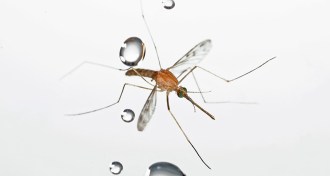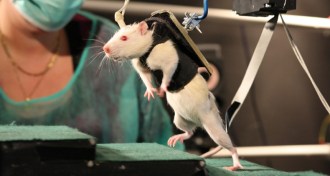Life
Sign up for our newsletter
We summarize the week's scientific breakthroughs every Thursday.
-
 Life
LifeMicrobes flourish under Arctic sea ice
Oceanographic expedition surprised to find photosynthetic microorganisms thriving under frozen surface.
By Devin Powell -
 Animals
AnimalsHow a mosquito survives a raindrop hit
Lightweight insects can ride a water droplet, as long as they separate from it before hitting the ground.
By Susan Milius -
 Life
LifeAncient birds wiped out huge insects
Competition in the air trumped the advantage of extra atmospheric oxygen.
By Devin Powell -
 Life
LifeAntiaging protein helps set daily rhythms
Changing levels of sirtuin in the brain alter activity patterns in mice.
-
 Earth
EarthDefying Depth
How deep-sea creatures, and close relatives, survive tons of water weight.
By Susan Gaidos -
 Genetics
GeneticsPoppies make more than opium
A 10-gene cluster controls the flowers’ production of a valuable cough suppressant and antitumor compound.
-
 Life
LifeTreatment helps paralyzed rats walk
A combination of drugs, electrical stimulation and therapy can restore lost connections between lower limbs and brain.
-
 Life
LifeBlue-green algae release chemical suspected in some amphibian deformities
Retinoic acid levels high in waterways rich in cyanobacteria blooms.
By Susan Milius -
 Animals
AnimalsBat killer hits endangered grays
The news on white-nose syndrome just keeps spiraling downward. The fungal infection, which first emerged six years ago, has now been confirmed in a seventh species of North American bats — the largely cave-dwelling grays (Myotis grisecens). The latest victims were struck while hibernating this past winter in two Tennessee counties.
By Janet Raloff -
 Life
LifeHow not to eat the wrong frog
Panamanian bats use an array of senses to keep from ingesting poison prey.
By Susan Milius -
 Life
LifeBlue light tells plants when to flower
Protein that marks day length also coordinates blooming genes.
-
 Life
LifeDelay of bloom blamed on climate change
Flowers that appear immune to global warming in spring may simply be taking a cue from the previous warmer autumn.
By Susan Milius